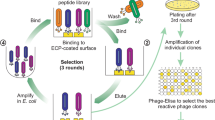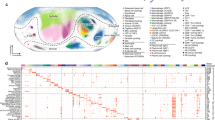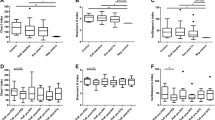Abstract
Background:
Defensins are antimicrobial peptides expressed on mucosal surfaces that contribute to maintaining intestinal homeostasis by providing innate defense mechanisms for the epithelia. Defensin expression is altered in a number of diseases that affect mucosal surfaces, such as atopic dermatitis, allergic rhinitis, and inflammatory bowel disease. Similar to atopic dermatitis, eosinophilic esophagitis (EoE) is a chronic disease in which the squamous epithelial surface is affected by a similar TH2 microenvironment and eosinophil-predominant inflammation. Therefore, we hypothesized that defensin expression would be decreased in EoE.
Methods:
To address this, we measured defensin expression in vitro in cell lines derived from patients with EoE (EoE1-T) or gastroesophageal reflux disease (GERD) (NES-G4T cells) and ex vivo in esophageal mucosal biopsy samples from children with EoE or GERD and control children without esophageal disease.
Results:
Interleukin-5 induced a decrease in human β-defensin (hBD) -1 and hBD3 expression in EoE1-T but not in NES-G4T cells. Compared with esophageal biopsy specimens from GERD and control children, specimens from EoE pediatric patients revealed a significant decrease in mRNA and protein expression for hBD1 and hBD3.
Conclusion:
Diminished expression of hBD1 and hBD3 may make the esophageal epithelium more susceptible to the development and/or perpetuation of EoE.
Similar content being viewed by others
Log in or create a free account to read this content
Gain free access to this article, as well as selected content from this journal and more on nature.com
or
References
Canny G, Levy O, Furuta GT, et al. Lipid mediator-induced expression of bactericidal/ permeability-increasing protein (BPI) in human mucosal epithelia. Proc Natl Acad Sci USA 2002;99:3902–7.
Ganz T . Defensins and host defense. Science 1999;286:420–1.
Ouellete AJ . Defensin-mediated innate immunity in the small intestine. Best Pract Res Clin Gastroenterol 2004;18:405–12.
Wehkamp J, Harder J, Weichenthal M, et al. Inducible and constitutive beta-defensins are differentially expressed in Crohn’s disease and ulcerative colitis. Inflamm Bowel Dis 2003;9:215–23.
Zanger P, Holzer J, Schleucher R, Scherbaum H, Schittek B, Gabrysch S . Severity of Staphylococcus aureus infection of the skin is associated with inducibility of human beta-defensin 3 but not human beta-defensin 2. Infect Immun 2010;78:3112–7.
O’Neil DA, Porter EM, Elewaut D, et al. Expression and regulation of the human beta-defensins hBD-1 and hBD-2 in intestinal epithelium. J Immunol 1999;163:6718–24.
Nomura I, Goleva E, Howell MD, et al. Cytokine milieu of atopic dermatitis, as compared to psoriasis, skin prevents induction of innate immune response genes. J Immunol 2003;171:3262–9.
Nomura I, Gao B, Boguniewicz M, Darst MA, Travers JB, Leung DY . Distinct patterns of gene expression in the skin lesions of atopic dermatitis and psoriasis: a gene microarray analysis. J Allergy Clin Immunol 2003;112:1195–202.
Ong PY, Ohtake T, Brandt C, et al. Endogenous antimicrobial peptides and skin infections in atopic dermatitis. N Engl J Med 2002;347:1151–60.
Howell MD, Gallo RL, Boguniewicz M, et al. Cytokine milieu of atopic dermatitis skin subverts the innate immune response to vaccinia virus. Immunity 2006;24:341–8.
Howell MD, Kim BE, Gao P, et al. Cytokine modulation of atopic dermatitis filaggrin skin expression. J Allergy Clin Immunol 2007;120:150–5.
Howell MD, Wollenberg A, Gallo RL, et al. Cathelicidin deficiency predisposes to eczema herpeticum. J Allergy Clin Immunol 2006;117:836–41.
Prado-Montes de Oca E, Garcia-Vargas A, Lozano-Inocencio R, et al. Association of beta-defensin 1 single nucleotide polymorphisms with atopic dermatitis. Int Arch Allergy Immunol 2007;143:211–8.
Mohamed HG, Abbas A, El-Kabarity RH, Diab HM . Association of beta-defensin 1 single nucleotide polymorphism with atopic dermatitis. Egypt J Immunol 2009;16:125–38.
Cassell H, Mukkada V, Woodruff SA, et al. Atopy in children with eosinophilic esophagitis (EoE) and gastroesophageal reflux disease (GERD). J Food Allergy 2012;1:5–11.
Liacouras CA, Furuta GT, Hirano I, et al. Eosinophilic esophagitis: updated consensus recommendations for children and adults. J Allergy Clin Immunol 2011;128:3–20.e6; quiz 21–2.
Rothenberg ME . Biology and treatment of eosinophilic esophagitis. Gastroenterology 2009;137:1238–49.
Straumann A, Bauer M, Fischer B, Blaser K, Simon HU . Idiopathic eosinophilic esophagitis is associated with a T(H)2-type allergic inflammatory response. J Allergy Clin Immunol 2001;108:954–61.
Lucendo AJ, De Rezende L, Comas C, Caballero T, Bellón T . Treatment with topical steroids downregulates IL-5, eotaxin-1/CCL11, and eotaxin-3/CCL26 gene expression in eosinophilic esophagitis. Am J Gastroenterol 2008;103:2184–93.
Blanchard C, Stucke EM, Rodriguez-Jimenez B, et al. A striking local esophageal cytokine expression profile in eosinophilic esophagitis. J Allergy Clin Immunol 2011;127:208–17, 217.e1–7.
Mishra A, Wang M, Pemmaraju VR, et al. Esophageal remodeling develops as a consequence of tissue specific IL-5-induced eosinophilia. Gastroenterology 2008;134:204–14.
Straumann A, Kristl J, Conus S, et al. Cytokine expression in healthy and inflamed mucosa: probing the role of eosinophils in the digestive tract. Inflamm Bowel Dis 2005;11:720–6.
Straumann A, Conus S, Grzonka P, et al. Anti-interleukin-5 antibody treatment (mepolizumab) in active eosinophilic oesophagitis: a randomised, placebo-controlled, double-blind trial. Gut 2010;59:21–30.
Ghadilly R . 25 years of epidermal stem cell research. J Invest Dermatol 2012;123:797–810.
Zasloff M . Antibiotic peptides as mediators of innate immunity. Curr Opin Immunol 1992;4:3–7.
Wehkamp J, Stange EF, Fellermann K . Defensin-immunology in inflammatory bowel disease. Gastroenterol Clin Biol 2009;33 Suppl 3:S137–44.
Hosaka Y, Koslowski M, Nuding S, et al. Antimicrobial host defense in the upper gastrointestinal tract. Eur J Gastroenterol Hepatol 2008;20:1151–8.
Kiehne K, Brunke G, Meyer D, Harder J, Herzig KH . Oesophageal defensin expression during Candida infection and reflux disease. Scand J Gastroenterol 2005;40:501–7.
Howell MD, Fairchild HR, Kim BE, et al. Th2 cytokines act on S100/A11 to downregulate keratinocyte differentiation. J Invest Dermatol 2008;128:2248–58.
Wollenberg A, Räwer HC, Schauber J . Innate immunity in atopic dermatitis. Clin Rev Allergy Immunol 2011;41:272–81.
Kim BE, Leung DY . Epidermal barrier in atopic dermatitis. Allergy Asthma Immunol Res 2012;4:12–6.
Albanesi C, Fairchild HR, Madonna S, et al. IL-4 and IL-13 negatively regulate TNF-alpha- and IFN-gamma-induced beta-defensin expression through STAT-6, suppressor of cytokine signaling (SOCS)-1, and SOCS-3. J Immunol 2007;179:984–92.
Howell MD, Boguniewicz M, Pastore S, et al. Mechanism of HBD-3 deficiency in atopic dermatitis. Clin Immunol 2006;121:332–8.
Wehkamp J, Salzman NH, Porter E, et al. Reduced Paneth cell alpha-defensins in ileal Crohn’s disease. Proc Natl Acad Sci USA 2005;102:18129–34.
Simms LA, Doecke JD, Walsh MD, Huang N, Fowler EV, Radford-Smith GL . Reduced alpha-defensin expression is associated with inflammation and not NOD2 mutation status in ileal Crohn’s disease. Gut 2008;57:903–10.
Fellermann K, Stange DE, Schaeffeler E, et al. A chromosome 8 gene-cluster polymorphism with low human beta-defensin 2 gene copy number predisposes to Crohn disease of the colon. Am J Hum Genet 2006;79:439–48.
Vordenbäumen S, Pilic D, Otte JM, Schmitz F, Schmidt-Choudhury A . Defensin-mRNA expression in the upper gastrointestinal tract is modulated in children with celiac disease and Helicobacter pylori-positive gastritis. J Pediatr Gastroenterol Nutr 2010;50:596–600.
Jaiswal KR, Morales CP, Feagins LA, et al. Characterization of telomerase-immortalized, non-neoplastic, human Barrett’s cell line (BAR-T). Dis Esophagus 2007;20:256–64.
Harder J, Bartels J, Christophers E, Schroder JM . Isolation and characterization of human beta -defensin-3, a novel human inducible peptide antibiotic. J Biol Chem 2001;276:5707–13.
Isomoto H, Mukae H, Ishimoto H, et al. High concentrations of human beta-defensin 2 in gastric juice of patients with Helicobacter pylori infection. World J Gastroenterol 2005;11:4782–7.
Acknowledgements
We thank Caleb Kelly for his technical support with in vitro experiments. We thank the physicians (Robert Kramer, Edward Hoffenberg, Edwin Liu, Edwin de Zoeten, Shikha Sundaram, Cara Mack, Michael Narkewicz, Ronald Sokol, Jason Soden, Deborah Neigut, David Brumbaugh, and Christine Waasdorp Hurtado), nurses (Tamela Armstrong and Jo Anne Newton), and technical staff (Bill Marcovich) who contributed to this work by helping to collect samples and enrolling subjects. We are grateful to our patients and families who consented to be a part of this study.
Author information
Authors and Affiliations
Corresponding author
Rights and permissions
About this article
Cite this article
Schroeder, S., Robinson, Z., Masterson, J. et al. Esophageal human β-defensin expression in eosinophilic esophagitis. Pediatr Res 73, 647–654 (2013). https://doi.org/10.1038/pr.2013.23
Received:
Accepted:
Published:
Issue date:
DOI: https://doi.org/10.1038/pr.2013.23



